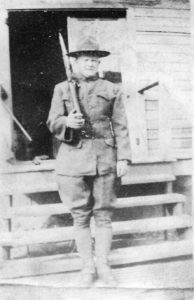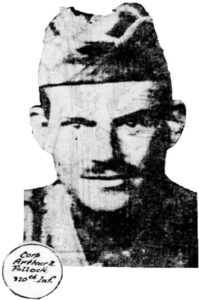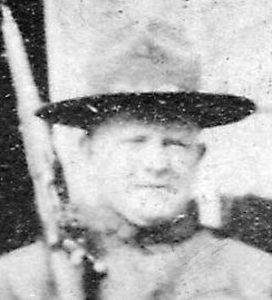Russell Thomas Stewart was born September 16, 1889 in Buffington Township, Indiana County, Pennsylvania. He was a son of John Galbreath Stewart and Mary (McKee) Stewart. He was probably born on, or near, the Stewart homestead, a farm originally settled by his great great-grandparents, John and Margaret (McFarland) Stewart about 1796. When Russell was five years old his father died, and his mother moved the family to Turtle Creek, Pennsylvania, a suburb of Pittsburgh.
Continue reading »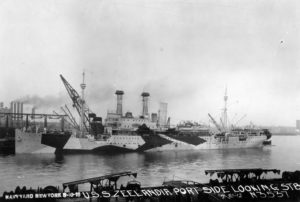
The Zeelandia was a passenger ship converted for use as a troop transport by the United States Navy during World War I. My granduncle Russell T. Stewart sailed on the USS Zeelandia on her first voyage to France in 1918. While researching his experiences, I discovered some interesting facts about this ship.
Shown here at New York harbor on May 10, 1918, the ship had been newly outfitted. She sports a new coat of paint known as dazzle camouflage, also called razzle dazzle. Rather than conceal the ship, it was intended to make it difficult for enemy submarines to determine the ship’s range and speed.
The Zeelandia was a Dutch commercial passenger ship named after Zeeland, the westernmost province of the Netherlands. She was built in 1910 in Scotland, and owned and operated by Koninklijke Hollandsche Lloyd (Royal Holland Lloyd) based in Amsterdam. How she became a US Navy transport is interesting.
Continue reading »A Pittsburgh newspaper article published three months after the end of World War I highlights the battle at Imécourt, France.1 It was of particular interest to Pittsburgh readers because most of the men who fought there were from Pittsburgh. It was the final battle for the 319th Infantry Regiment, part of the 80th Division. Several men were killed in action there, including my granduncle, Russell T. Stewart.2
Continue reading »Footnotes- Charles J. Doyle, “Field Where Home Boys Lie Photographed,” The Pittsburgh Gazette Times, Sunday, February 9, 1919, page 47 (section 6, page 5). Google News Archive (https://news.google.com/newspapers?id=mG1RAAAAIBAJ&sjid=BGgDAAAAIBAJ&pg=2431%2C1364060 : viewed 2 January 2020).
- Photo from Dennis Stewart, MyHeritage.com, Robert M. Stewart Family (https://www.myheritage.com/site-148784861/robert-m-stewart-family : Downloaded 23 June 2016), Thomas Russell Stewart.
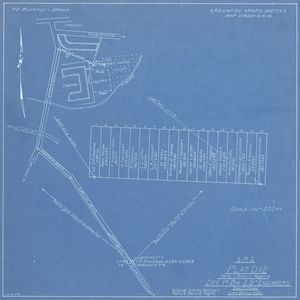
There are new details to report about my granduncle, Russell T. Stewart, who was killed in action during World War I. It was common to bury fallen soldiers near where they died. For several years after the war, their remains were subsequently exhumed and their identity confirmed. They were then reburied in France, or returned to their families in the United States for funerals here.
It is somewhat fortunate that Russell was first buried at a relatively nice place, rather than in an open field or dense forest. He died during a battle just northwest of Imécourt, France on November 2, 1918. His body was returned to the town of Imécourt and buried by a regimental burial detail on the grounds of the Chateau d’Imécourt. There were eighteen altogether. In fact he was buried next to Grover D. Selvey and Aaron Carter, and all three were in Company M.
Continue reading »
This is a Memorial Day tribute to Pfc. Russell T. Stewart, my mother’s uncle, who was killed in action in the woods northwest of Imécourt, France early on the morning of November 2, 1918. He served in Company M, 3rd Battalion, 319th Infantry, 160th Brigade, 80th Division. The Division earned the motto, “Only Moves Forward,” having fought in all three phases of the Meuse-Argonne Offensive, from September through November, 1918.
Continue reading » A motion picture is a series of still photographs displayed in rapid succession. You probably know the line spoken just before the photograph at left was taken. That’s because you already saw Gone With the Wind. If you hadn’t, I could show you more and more still photos until eventually the scene came to life.
A motion picture is a series of still photographs displayed in rapid succession. You probably know the line spoken just before the photograph at left was taken. That’s because you already saw Gone With the Wind. If you hadn’t, I could show you more and more still photos until eventually the scene came to life.
A historical photograph is an instant in time. Like a single frame from a movie, it provides limited information. When you can add additional photographs taken about the same time, you get a better perspective and therefore a greater appreciation.
Russell Thomas Stewart was my maternal granduncle. He served in the 80th Infantry Division during World War I and was killed in action November 2, 1918. I wanted to know exactly what happened to him, but I doubt anyone ever knew, or could know, precisely what happened that fateful day. In the confusion of battle, most details are never reported or recorded.1 (Refer also to my earlier posts: Russell Stewart: Only Moves Forward and Corporal Pollock’s Account.)
I used Divisional, Regimental and Company histories to piece together his story. I can only estimate where Russell was based on the unit to which he was assigned. It is possible he was separated from his unit and temporarily attached to another unit. It is also possible he died the day before and he was not found until the next day.
Russell served in Company M, one of four companies in the 3rd Battalion of the 319th Infantry.2 The 319th was part of the 160th Brigade in the 80th Infantry Division.
Continue reading »Footnotes
- Photo from Dennis Stewart, MyHeritage.com, Robert M. Stewart Family (https://www.myheritage.com/site-148784861/robert-m-stewart-family : Downloaded 23 June 2016), Thomas Russell Stewart.
- “Pennsylvania, WWI Veterans Service and Compensation Files, 1917-1919, 1934-1948,” database online, Ancestry.com Operations, Inc., 2015, Ancestry.com (http://ancestry.com: Downloaded 6 July 2016), Stewart, Russell T; citing World War I Veterans Service and Compensation File, 1934–1948. RG 19, Series 19.91. Pennsylvania Historical and Museum Commission, Harrisburg Pennsylvania.

Lt. Col. Ashby Williams
I must admit I was not very familiar with World War I history. I had studied it in school history classes, watched the old movies and read a couple books on the subject. I never really appreciated the courage and bravery of those who served in that war until I investigated the life of my mother’s uncle, Private First Class Russell Stewart. He served in Company M of the 319th Infantry Regiment, 80th Infantry Division. He died at the battle of the Meuse-Argonne on November 2, 1918, just as the war was ending.
In reading the relevant regimental and divisional accounts of that battle, I found the most interesting and moving account of all. It was written by Lieutenant Colonel Ashby Williams (1874-1944)1 in his book, “Experiences of the Great War” (Roanoke, Virginia: The Stone Printing and Manufacturing Company, 1919). He started out as commander of Company E, 320th Infantry and was promoted to battalion commander, with the rank of Major, over Companies A, B, C and D, of the 320th. Although he was an officer, he endured only slightly better conditions than his men. He describes in great detail the experience of the Meuse-Argonne Offensive.
The 320th and 319th were in the same brigade, the 160th, and undoubtedly shared the same locations, movements and conditions. Therefore his is probably the closest description of what my granduncle experienced. I have included here the most poignant and eloquent passages from Lt. Col. Williams’ book. His words describe the indescribable horrors of existence and death in the trenches. It is something the world often forgets, as I did, in my generation. But now I remember.
Continue reading »Footnotes
- Jim Tipton, Find A Grave (http://www.findagrave.com/: Downloaded 16 August 2016), John Ashby “Ashby” Williams, Sr (1874-1944), Memorial 64601385.
Corporal Arthur Nelan Pollock served in Company F, 320th Infantry Regiment, 80th Infantry Division during the Meuse-Argonne Offensive in World War I. Amazingly, he kept a diary. It so happens he got separated from his regiment and became attached to the 319th Infantry. This was the same regiment in which my granduncle Russell Stewart served, as I describe in a previous post.
It is enlightening to read Corporal Pollock’s account of the battle. Since both men were then in the same regiment, this is very likely what Russell Stewart also experienced. Here is an excerpt of Corporal Pollock’s account from September 26 to October 2, 1918. It was originally published in the Pittsburgh Press, April 20, 1919 and continued on May 18, 1919. This excerpt was transcribed by Lynn Beatty and the full text is found at the Allegheny County, Pennsylvania USGenWeb.1
Continue reading »Footnotes
- Pennsylvania, USGenWeb Archives, Allegheny County, Military, World War I, (http://www.usgwarchives.net/pa/allegheny/military/wpa-ww1/chapter-16.htm : 3 August 2016.)
 There once was a precious little girl named Violet who died at age 2. More than one hundred years later, it is she who helped me unravel a compelling mystery.
There once was a precious little girl named Violet who died at age 2. More than one hundred years later, it is she who helped me unravel a compelling mystery.
My granduncle Russell Thomas Stewart was my maternal grandfather’s younger brother. In a family tree published by my second cousin, Robert M. Stewart, there is a somber copy of a telegram addressed to my great-grandmother, Mary (McKee) Stewart, and dated December 5, 1918.1 It was news that her son Russell Stewart was killed in action November 2, 1918.
Finding no other information, I decided to investigate the short life of my granduncle, who I had never heard about. I was able to find a little more about him, but his story is mostly the tragedy of World War I and the sad ironies of its end.
Continue reading »Footnotes

